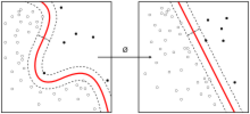Double descent

In statistics and machine learning, double descent is the phenomenon where a statistical model with a small number of parameters and a model with an extremely large number of parameters have a small error, but a model whose number of parameters is about the same as the number of data points used to train the model will have a large error.[2]
History
Early observations of double descent in specific models date back to 1989,[3][4] while the double descent phenomenon as a broader concept shared by many models gained popularity around 2019.[5][6] The latter development was prompted by a perceived contradiction between the conventional wisdom that too many parameters in the model result in a significant error (an extrapolation of bias-variance tradeoff),[7] and the empirical observations in the 2010s that some modern machine learning models tend to perform better with larger models.[5][8]
Modelling of double descent
A model of double descent at the thermodynamic limit has been analyzed by the replica method, and the result has been confirmed numerically.[9] The scaling behavior of double descent has been found to follow a broken neural scaling law[10] functional form.
References
- ↑ Schaeffer, Rylan; Khona, Mikail; Robertson, Zachary; Boopathy, Akhilan; Pistunova, Kateryna; Rocks, Jason W.; Fiete, Ila Rani; Koyejo, Oluwasanmi (2023-03-24). "Double Descent Demystified: Identifying, Interpreting & Ablating the Sources of a Deep Learning Puzzle". arXiv:2303.14151v1 [cs.LG].
- ↑ "Deep Double Descent" (in en). 2019-12-05. https://openai.com/blog/deep-double-descent/.
- ↑ Vallet, F.; Cailton, J.-G.; Refregier, Ph (June 1989). "Linear and Nonlinear Extension of the Pseudo-Inverse Solution for Learning Boolean Functions" (in en). Europhysics Letters 9 (4): 315. doi:10.1209/0295-5075/9/4/003. ISSN 0295-5075. https://dx.doi.org/10.1209/0295-5075/9/4/003.
- ↑ Loog, Marco; Viering, Tom; Mey, Alexander; Krijthe, Jesse H.; Tax, David M. J. (2020-05-19). "A brief prehistory of double descent" (in en). Proceedings of the National Academy of Sciences 117 (20): 10625–10626. doi:10.1073/pnas.2001875117. ISSN 0027-8424. PMID 32371495. PMC 7245109. https://pnas.org/doi/full/10.1073/pnas.2001875117.
- ↑ 5.0 5.1 Belkin, Mikhail; Hsu, Daniel; Ma, Siyuan; Mandal, Soumik (2019-08-06). "Reconciling modern machine learning practice and the bias-variance trade-off". Proceedings of the National Academy of Sciences 116 (32): 15849–15854. doi:10.1073/pnas.1903070116. ISSN 0027-8424. PMID 31341078.
- ↑ Viering, Tom; Loog, Marco (2023-06-01). "The Shape of Learning Curves: A Review". IEEE Transactions on Pattern Analysis and Machine Intelligence 45 (6): 7799–7819. doi:10.1109/TPAMI.2022.3220744. ISSN 0162-8828. https://ieeexplore.ieee.org/document/9944190/.
- ↑ Eric (2023-01-10). "The bias-variance tradeoff is not a statistical concept" (in en). https://www.ericjwang.com/2023/01/10/bias-variance.html.
- ↑ Preetum Nakkiran; Gal Kaplun; Yamini Bansal; Tristan Yang; Boaz Barak; Ilya Sutskever (29 December 2021). "Deep double descent: where bigger models and more data hurt". Theory and Experiment (IOP Publishing Ltd and SISSA Medialab srl) 2021 (12): 124003. doi:10.1088/1742-5468/ac3a74. Bibcode: 2021JSMTE2021l4003N.
- ↑ Advani, Madhu S.; Saxe, Andrew M.; Sompolinsky, Haim (2020-12-01). "High-dimensional dynamics of generalization error in neural networks". Neural Networks 132: 428–446. doi:10.1016/j.neunet.2020.08.022. ISSN 0893-6080. PMC 7685244. https://www.sciencedirect.com/science/article/pii/S0893608020303117.
- ↑ Caballero, Ethan; Gupta, Kshitij; Rish, Irina; Krueger, David (2022). "Broken Neural Scaling Laws". International Conference on Learning Representations (ICLR), 2023.
| Machine learning and data mining |
|---|
 |
Further reading
- Mikhail Belkin; Daniel Hsu; Ji Xu (2020). "Two Models of Double Descent for Weak Features". SIAM Journal on Mathematics of Data Science 2 (4): 1167–1180. doi:10.1137/20M1336072.
- Preetum Nakkiran; Gal Kaplun; Yamini Bansal; Tristan Yang; Boaz Barak; Ilya Sutskever (29 December 2021). "Deep double descent: where bigger models and more data hurt". Theory and Experiment (IOP Publishing Ltd and SISSA Medialab srl) 2021 (12): 124003. doi:10.1088/1742-5468/ac3a74. Bibcode: 2021JSMTE2021l4003N.
- Song Mei; Andrea Montanari (April 2022). "The Generalization Error of Random Features Regression: Precise Asymptotics and the Double Descent Curve". Communications on Pure and Applied Mathematics 75 (4): 667–766. doi:10.1002/cpa.22008.
- Xiangyu Chang; Yingcong Li; Samet Oymak; Christos Thrampoulidis (2021). "Provable Benefits of Overparameterization in Model Compression: From Double Descent to Pruning Neural Networks". Proceedings of the AAAI Conference on Artificial Intelligence 35 (8).
External links
- "Double Descent: Part 1: A Visual Introduction". https://mlu-explain.github.io/double-descent/.
- "Double Descent: Part 2: A Mathematical Explanation". https://mlu-explain.github.io/double-descent2/.
- Understanding "Deep Double Descent" at evhub.
 |

